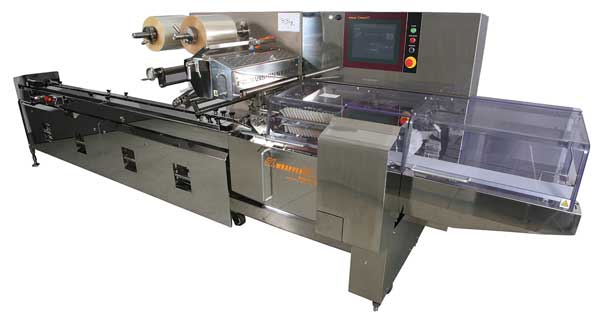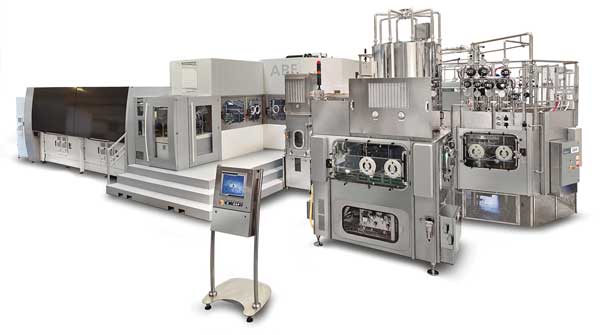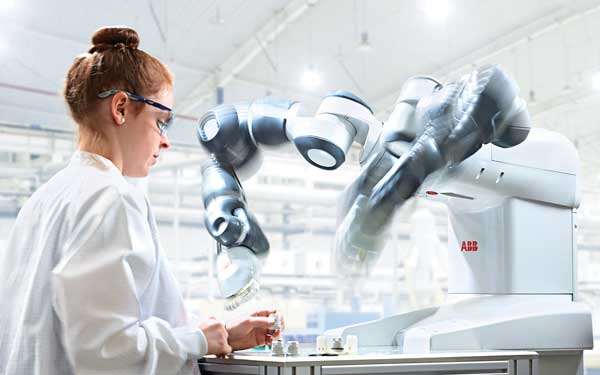Agile Packaging Machinery
PACKAGING
Flexibility has become a major factor in equipment design and purchase. According to Mintel, the redesigning of packaging for existing products increased 89% while new food product introductions declined 38% from 2009 to 2014. Retail regional and global markets often dictate a multitude of package formats that require machine variability. To increase efficiencies after mergers and acquisitions, packaging machinery needs to be moved and altered to meet space constraints. Customized and limited-edition products have also increased the need for flexible package manufacturing. New food packaging lines have slide-in/slide-out machinery that accommodates numerous package types and consumes less capital than inflexible packaging lines. As a result, packaging machinery that can adapt to the latest packaging is crucial. Recent machinery advances provide a glimpse of what is possible in a more flexible machine.
 Pouch Packaging Machines
Pouch Packaging Machines
Flexible food packaging has increased at a rate of 10% since 2009. Horizontal-form-fill-seal (HFFS) and vertical-form-fill-seal (VFFS) and stand-up pouch (SUP) machines translate flexible film into food packaging. HFFS machines are suitable for packing fragile product such as cookies and for bakery products that need exact placement within a package. Gravity-fed products such as dry pet food and cereal are typically packed using VFFS machines. Both HFFS and VFFS machines are often used to pack a single product. For example, HFFS machines are used to pack mini candy bars, and then VFFS machines are used to pack 24 individually wrapped mini candy bars into an outer bag for retail sale. The use of film on a roll renders HFFS and VFFS pouches economical, allowing pouch options and an expansive array of oxygen, water, and carbon dioxide barriers to meet the needs of products, film thickness, modified atmosphere, and automation. Recent machinery advances are conducive to filling premade pouches and numerous pouch configurations.
The SUE 2520DZ VFFS machine by Bosch, Waiblingen, Germany (boschpackaging.com), is able to switch between three common pouch styles (quad, block bottom, and pillow). This ability to switch styles allows one machine to pack multiple types of products as well as pack the same product in different packages to fit Internet, convenience store, club store, and more traditional grocery store package-size needs. Machinery design innovation simplifies switching between different pouch types. The XYT15-RJ by Triangle, Chicago, Ill. (triangle package.com), has sealing jaws that rotate 90 degrees, no loose wires, and a mere three-step 10-minute changeover. Future modifications will shorten time and provide automation to ensure proper settings in the readjustment process. The VFFS Velocity by Viking Masek, Prague, Czech Republic (vikingmasek.com), fills 300 bags per minute, and the company’s recent investment in a new 35,000 sq ft factory in eastern Wisconsin foreshadows further innovation. Speed often does not need to be sacrificed for flexibility with new VFFS equipment. Speeds of 150 bags per minute have been combined with 10 bag-type options, and five reclosable solutions in the MS300 by Viking Masek. Sanitation, improved seals, reduced footprints and multiple package formats continue to drive innovation in HFFS and VFFS pouch machines.
A focus on ease of sanitation, seal integrity, and enhanced flexibility has produced major innovations in pouch machine design. The FW-3700 HFFS machine by Formost Fuji, Woodinville, Wash. (formostfuji.com), has open architecture and tool-less disassembly, which enables rapid cleaning, and a flush human-machine interface facilitates pre-approval by the U.S. Dept. of Agriculture’s Food Safety and Inspection Service for meat, poultry, and egg facilities. Improving seal integrity has been a focus on machine design improvements. Ultrasonic sealing, which provides seals suitable for retort and new processing technologies, has been plagued by slow speeds, but the MS SoniPAC by MS Industries, Webberville, Mich. (msspaichingen.de), can be seamlessly added to packaging machinery at viable speeds. As packaging continues the switch from rigid formats to film formats, further innovation in seal design is needed. Modification of existing machines and new machines to reduce footprints provide pouch variation, increase production speeds, and reduce changeover times. The Campbell Revolution Horizontal Food Wrapper by Campbell Wrapper, De Pere, Wis. (campbellwrapper.com), now features a cantilevered conveyor infeed that yields line speeds of 600 packages per minute, allows for ease of sanitation, and has a 20% smaller footprint than that of other HFFS machines. This type of modification of existing HFFS equipment provides economical speed and sanitation and saves space. HFFS pouches with tucks and folds enable products to stand on end and mimic an SUP. The Delta 3000 by Ilapak, Lugano, Switzerland (ilapak.com), accomplishes this with a three-side seal pouch that allows for uninterrupted graphics on front and back panels.
Premade SUPs provide the ability to pack gravity-fed products without the complexities and cost of an in-house machine to create a pouch. Consumer and retail interest in SUPs has led to a plethora of premade SUP filling machines and innovation in flexibility and speed. Among them is the Toyo Jidoki TT-8D-N by Matrix Packaging Machinery, Saukville, Wis. (matrixpm.com), which has a premade pouch filler/sealer that allows for gas flushing and dry and liquid filling. Higher line speeds and format-switching have resulted in the need to provide immediate package integrity assurance that can be used to both verify seals and adjust equipment. Systems such as the inline compression-based leak detection by Teledyne Taptone, North Falmouth, Mass. (taptone.com), are capable of detecting and rejecting pouches with pinholes as small as 0.02 in. The SUP market is growing at a 7% rate, and the FLX Alpha by AlliedFlex Technologies Inc., Sarasota, Fla. (alliedflex.com), has capability for small-scale fill-seal pouch production laboratory assessments and test-market packaging of standard and retort-able pouches with ultrasonic sealing.
--- PAGE BREAK ---
Cup and Tray Packaging Machines
Food packaging cup and tray operations can form containers before filling and sealing in the same form-fill-seal (FFS) production line. Forming cups and trays inline reduces cost, waste, amount of plastic resin, and contamination associated with producing and shipping empty injection molded cups. Yogurt packaging has profited from machinery innovation for FFS cups, and the cup market has recently grown by 10%. Group Danone’s yogurts come in cups that are thermo-formed, labeled, and filled before metallized lids are applied, all within a production line by Arcil, Pontoise, France (www.arcil.fr), that is capable of operating 350 cups per minute. Aseptic filling adds to yogurt shelf life, and the Hamba FL 8/8 CA by Oystar, Stutensee, Germany (oystar.de), aseptically fills 16 Fage yogurt cups in one cycle before applying a foil-based lid at 500 cups per minute. Shape innovation in the yogurt category with multiple compartments is indicative of the type of flexibility FFS cup machines can offer. Company mergers and acquisitions have resulted in the need to condense production and optimize production capacity. Flexible cup and tray FFS machines are a valuable capital asset. In essence, a machine used for yogurt packaging could be readily modified to use for hummus, sauces, and more solid products or be easily retooled for seasonal or marketing promotions or size changes.
Bakery sections within stores are experiencing 15% growth, and packaging innovation is meeting the need for product differentiation as the number of SKUs increase. The Repak by Reiser, Canton, Mass. (reiser.com), forms Mylar cups containing muffin mix. Mylar cups in trays resemble typical muffin trays, and consumers can place them directly in the oven. Mylar cups rise and shrink when muffins bake. Companies that make clean label and artisan bakery products that require no further baking are also employing the tray formats of Reiser, MultiVac, Wolfertschwenden, Germany (multivac.com), and other manufacturers. The package-based tray is formed from a film inline in a manner similar to the method utilized by Arcil machines for yogurt cups. Open architecture allows for rapid adjustment of the web width and forming cavities so that one machine can handle different package sizes. This machinery also meets the need of new processing techniques for sterilization and pasteurization. MultiVac’s partnership with high pressure processing (HPP) processor ThyssenKrupp Industrial Solutions Inc., Greenwood Village, Colo. (thyssenkrupp-industrial-solutions.com), has resulted in a four- to seven-log cycle reduction in yeast and psychrotrophic bacteria. This considerable innovation in packaging machinery allows a 30-day refrigerated shelf life for chilled meals.
 Bottling Machines
Bottling Machines
Although bottle packaging has declined 12% since 2009, advances in bottling machinery have continued to aid in forming, filling, and capping bottles inline. This allows for faster line speeds, a smaller footprint, greater versatility, and a more controlled sterile environment. Aseptic blow and fill rates of 800 bottles per minute have been reached. The closed system by GEA Group, Düsseldorf, Germany (gea.com), offers aseptic control and less sterilant with an integrated bottle blower, filler, and capper. The result is a bottle with 25% less resin that is suitable for low- and high-acid aseptic beverages. Beyond aseptic filling, the 160 filling nozzles and 20 capping stations associated with the Sidel Matrix Combi by Sidel, Hünenberg, Switzerland (sidel.com), start with blow-molding using 20 blowing stations, which allow 400 bottles per minute to be formed, filled, and capped.
 Automation Increases Flexibility
Automation Increases Flexibility
Across the spectrum of food packaging machines, automation has switched from delivering only speed to speed plus more-flexible manufacturing. Increased automation addresses ergonomic challenges associated with a smaller machine footprint and the need for multiple products and package types to be filled and sealed on the same machine. While automation was once reserved for heavy manufacturing, declines in scale and cost have made automation more viable for the food industry. Robots may offer the ultimate blend of automation and flexibility since they can be reprogrammed to adjust to different products and packages. Fanuc, Rochester Hills, Mich. (fanucamerica.com); ABB Robotics, Auburn Hills, Mich. (abb.us); Mitsubishi Electric Automation, Vernon Hills, Ill. (meau.com); and Rethink Robotics, Boston, Mass. (rethinkrobotics.com), offer collaborative robots that can be in direct contact with human production workers. These human-like robots are programmable, so they are flexible within a dynamic manufacturing environment. Flexible manufacturing environments enable newly redefined packaging generated by retailers, customization, mergers and acquisitions, and new processing technologies while maintaining a high level of food safety. Drop-in automation interfaces with machinery enable focused innovation and allow for one machine to meet multiple needs. Conveyors with a small turning radius allow for flexibility in package size and efficiency with smaller packages due to increased surface contact via high roller density and guides that handle packages. Belt-driven conveyors such as the 20-foot spiral by AmbaFlex, Bedford, Texas (ambaflex.com), also offer smaller footprints and dynamic accumulation without damaging product at 200 feet per minute. And BluePrint Automation Inc., Colonial Heights, Va. (bpa-flexolutions.com), and QComp Technologies, Greenville, Wis. (qcomptech.com), have smoothed package-product interface on production lines to accommodate new design and new products on existing packaging machinery. The DTL-3X: 3 Axis Delta Top Loader carton packer by Blue Print Automation reaches speeds of 500 cartons per minute and packs in horizontal and vertical configurations within one case.
In package machinery design, the need for manufacturing agility translates to small footprints for tight locations or to accommodate more machinery for a probable expansion, the ability to pack variable sizes on the same machine, and fast changeover. Recent machinery advances in improved flexibility forecast the innovative future of packaging machine design.
 Claire Koelsch Sand, PhD, Contributing Editor
Claire Koelsch Sand, PhD, Contributing Editor
President, Packaging Technology and Research
Adjunct Professor, Michigan State Univ.
[email protected]
